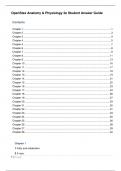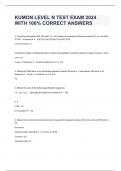OpenStax Anatomy & Physiology 2e Student Answer Guide
Contents
Chapter 1 .................................................................................................................................1
Chapter 2 .................................................................................................................................3
Chapter 3 .................................................................................................................................4
Chapter 4 .................................................................................................................................5
Chapter 5 .................................................................................................................................7
Chapter 6 .................................................................................................................................8
Chapter 7 .................................................................................................................................9
Chapter 8 ...............................................................................................................................11
Chapter 9 ...............................................................................................................................13
Chapter 10 .............................................................................................................................16
Chapter 11 .............................................................................................................................17
Chapter 12 .............................................................................................................................18
Chapter 13 .............................................................................................................................19
Chapter 14 .............................................................................................................................21
Chapter 15 .............................................................................................................................22
Chapter 16 .............................................................................................................................23
Chapter 17 .............................................................................................................................24
Chapter 18 .............................................................................................................................26
Chapter 19 .............................................................................................................................27
Chapter 20 .............................................................................................................................29
Chapter 21 .............................................................................................................................30
Chapter 22 .............................................................................................................................31
Chapter 23 .............................................................................................................................33
Chapter 24 .............................................................................................................................35
Chapter 25 .............................................................................................................................36
Chapter 26 .............................................................................................................................38
Chapter 27 .............................................................................................................................39
Chapter 28 .............................................................................................................................40
Chapter 1
1 Fatty acid catabolism.
3 X-rays.
1|Page
, 5 PET scans can indicate how patients are responding to chemotherapy.
6C
8A
10 D
12 C
14 C
16 C
18 C
20 D
22 D
24 D
26 C
28 An understanding of anatomy and physiology is essential for any career in the health
professions. It can also help you make choices that promote your health, respond
appropriately to signs of illness, make sense of health-related news, and help you in
your roles as a parent, spouse, partner, friend, colleague, and caregiver.
30 Chemical, cellular, tissue, organ, organ system, organism.
32 When you are sitting at a campfire, your sense of smell adapts to the smell of smoke.
Only if that smell were to suddenly and dramatically intensify would you be likely to
notice and respond. In contrast, the smell of even a trace of smoke would be new and
highly unusual in your residence hall, and would be perceived as danger.
34 In a sealed bottle of sparkling water, carbon dioxide gas is kept dissolved in the
water under a very high pressure. When you open the bottle, the pressure of the gas
above the liquid changes from artificially high to normal atmospheric pressure. The
dissolved carbon dioxide gas expands, and rises in bubbles to the surface. When a
bottle of sparkling water is left open, it eventually goes flat because its gases continue to
move out of solution until the pressure in the water is approximately equal to
atmospheric pressure.
36 The four components of a negative feedback loop are: stimulus, sensor, control
center, and effector. If too great a quantity of the chemical were excreted, sensors
would activate a control center, which would in turn activate an effector. In this case, the
effector (the secreting cells) would be adjusted downward.
38 If the body were supine or prone, the MRI scanner would move from top to bottom to
produce frontal sections, which would divide the body into anterior and posterior
2|Page
, portions, as in “cutting” a deck of cards. Again, if the body were supine or prone, to
produce sagittal sections, the scanner would move from left to right or from right to left
to divide the body lengthwise into left and right portions.
be performed repeatedly.
Chapter 2
1 The mass number is the total number of protons and neutrons in the nucleus of an atom.
3 The water hydrolyses, or breaks, the glycosidic bond, forming two monosaccharides.
4D
6A
8B
10 C
12 B
14 A
16 C
18 A
20 B
22 D
24 B
26 A
28 B
30 D
32 B
33 These four elements—oxygen, carbon, hydrogen, and nitrogen—together make up
more than 95 percent of the mass of the human body, and the body cannot make
elements, so it is helpful to have them in consumables.
35 Magnesium’s 12 electrons are distributed as follows: two in the first shell, eight in the
second shell, and two in its valence shell. According to the octet rule, magnesium is
unstable (reactive) because its valence shell has just two electrons. It is therefore likely
to participate in chemical reactions in which it donates two electrons.
37 Water is a polar molecule. It has a region of weakly positive charge and a region of
3|Page
, weakly negative charge. These regions are attracted to ions as well as to other polar
molecules. Oils are nonpolar,
and are repelled by water.
39 It is not. An exchange reaction might be AB + CD → AC + BD or AB + CD → AD +
BC . In allchemical reactions, including exchange reactions, the components of the
reactants are identical to the components of the products. A component present among
the reactants cannot disappear, nor can a component not present in the reactants
suddenly appear in the products. 41 Lemon juice is one hundred times more acidic than
orange juice. This means that lemon juice has a one hundred-fold greater concentration
of hydrogen ions.
43 Maltose contains 12 atoms of carbon, but only 22 atoms of hydrogen and 11 atoms
of oxygen, because a molecule of water is removed during its formation via dehydration
synthesis.
Chapter 3
1 Higher temperatures speed up diffusion because molecules have more kinetic energy
at highertemperatures.
3 an enzyme
5 the spindle
6B
8C
10 D
12 A
14 A
16 C
18 A
20 C
22 C
24 B
26 B
28 C
30 Only materials that are relatively small and nonpolar can easily diffuse through the
lipid bilayer. Large particles cannot fit in between the individual phospholipids that are
packed together, and polar molecules are repelled by the hydrophobic/nonpolar lipids
that line the inside of the bilayer.
4|Page






